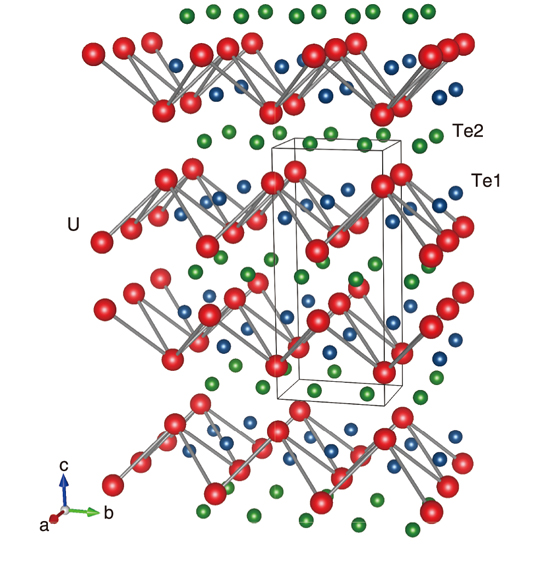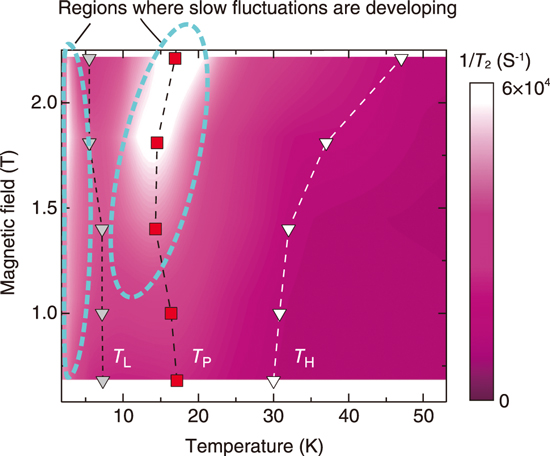
Fig.3-6 Crystal structure of UTe2

Fig.3-7 Field–temperature phase diagram of the nuclear spin–spin relaxation rate (1/T2)
The discovery of new materials with new electronic properties is the foundation of technological innovations such as computers, mobile phones and the Internet that have the potential to dramatically change our social lives. Materials contain a huge number of electrons, about the same as Avogadro’s number, and new electronic properties, such as new magnetism and superconductivity, often emerge when these electrons are strongly correlated with each other. Recently, strongly correlated uranium compounds have received much attention as a platform for discovering new electronic properties.
The uranium compound UTe2 (Fig.3-6) is a novel superconductor. It discovered at the end of 2018. In ordinary spin-singlet superconductors, the spins of the pairing electrons responsible for superconductivity are aligned in opposite directions. However, in UTe2, the spins are aligned in the same direction, resulting in a new superconducting state called the spin-triplet state.
In this study, we used nuclear magnetic resonance (NMR) techniques to investigate the electronic states of UTe2. The NMR is an experimental technique that allows us to investigate the electronic state from a microscopic viewpoint. For this study, we grew a special UTe2 single crystal enriched with NMR-observable 125Te nuclei from 7% of their natural abundance to 99%. Using the crystal, we measured the nuclear spin–spin relaxation rate (1/T2) and investigated the strength of spin and charge fluctuations inside the material. We found that slow fluctuations with frequencies below the megahertz scale, which are extremely low for electronic systems, appear at low temperatures below about 30 K (Fig.3-7). The appearance of such slow fluctuations indicates the development of strong interactions (long-range correlations) between uranium atoms, which have the characteristic structure shown in Fig.3-6. The role played by such slow fluctuations in the mechanism of spin-triplet superconductivity remains to be clarified.
Uranium-based spin-triplet superconductors, such as UTe2, are now attracting much attention as systems that realize “topological superconductivity” in the bulk. The topological superconductivity is expected to be applied to next-generation quantum computing. If the mechanism of the spin-triplet superconductivity can be elucidated using UTe2, it may become possible to design and develop new topological superconductors by applying the mechanism.
This study was supported by JSPS KAKENHI Grant-in-Aid for Scientific Research (A) (JP20H00130) “Spin-triplet superconductivity on Uranium-based compounds”.
(Yo Tokunaga)